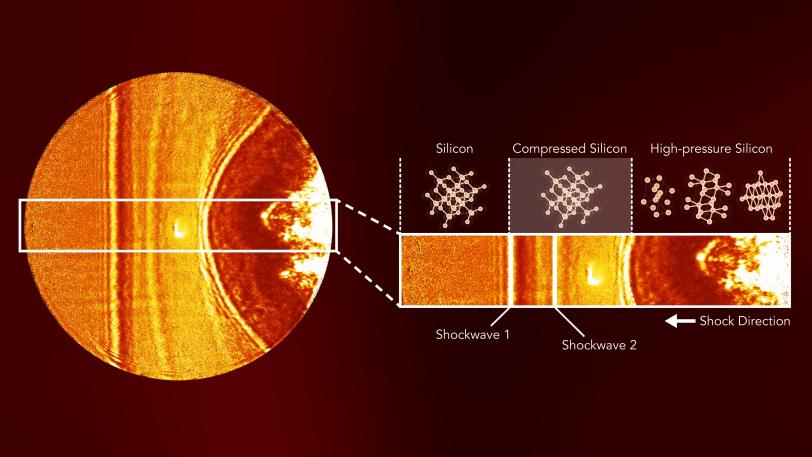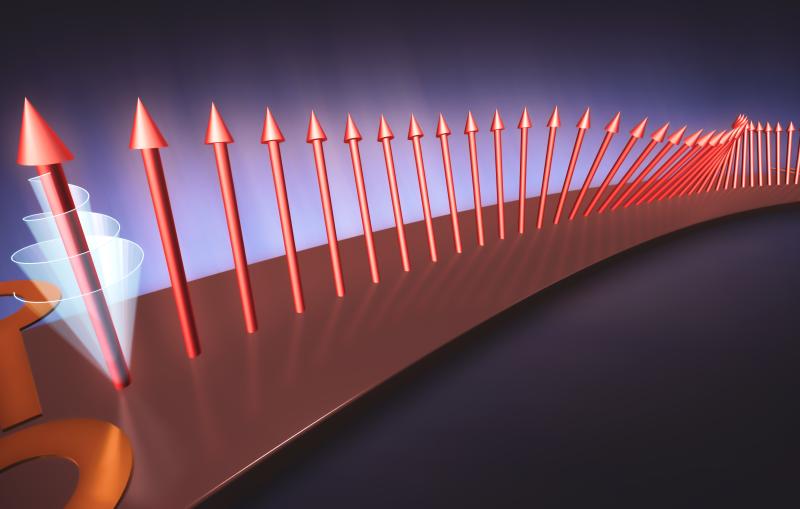A new lens on materials under extreme conditions allows researchers to watch shock waves travel through silicon
Researchers used a unique approach to learn more about what happens to silicon under intense pressure.
Elasticity, the ability of an object to bounce back to its original shape, is a universal property in solid materials. But when pushed too far, materials change in unrecoverable ways: Rubber bands snap in half, metal frames bend or melt and phone screens shatter.
For instance, when silicon, an element abundant in the Earth’s crust, is subjected to extreme heat and pressure, an initial “elastic” shock wave travels through the material, leaving it unchanged, followed by an “inelastic” shock wave that irreversibly transforms the structure of the material.
Using a new technique, researchers were able to directly watch and image this process. To their surprise, they discovered that it included an extra step that had not been seen before: After the first elastic shock wave traveled through the silicon, a second elastic wave appeared before the final inelastic wave changed the material’s properties.
Their results were published in Science Advances last week.
“We discovered that this transformation is more nuanced than previously thought,” says Shaughnessy Brennan Brown, a postdoctoral candidate at Stanford University and graduate research associate at the Department of Energy’s SLAC National Accelerator Laboratory who led the analysis. “We illuminated an entirely new feature potentially observable in other materials.”
Seeing through a new lens
In addition to contributing to a deeper understanding of silicon, a material that is important in fields like engineering, geophysics and plasma physics, this new technique lights the path for solving problems in other fields.
“The platform Shaughnessy developed is also useful in areas like meteoritics,” says co-author Arianna Gleason-Holbrook, a staff scientist at the Stanford Institute for Materials and Energy Sciences (SIMES) at SLAC. “Let’s say a large metal impactor, like the remnant core of some planet, hits a terrestrial planet. This technique will allow us to zoom in and spatially walk through the history of that type of shock to answer a number of important questions, like how life gets delivered to a new planet or what happens during asteroid collisions.”
“It’s almost like you’ve had blurry vision for a while,” she says, “but then you put on glasses and the world opens up. What we’ve done in this paper is provide a new lens on materials properties.”
Catching the wave
At SLAC, researchers can see what’s happening deep in the belly of samples by hitting them with ultrafast X-ray laser pulses from the Linac Coherent Light Source (LCLS), and then using the patterns formed by the scattered X-rays to reconstruct images.
At the Matter in Extreme Conditions (MEC) instrument, researchers blast the samples with intense pulses from a second high-power laser before hitting them with X-rays to watch how materials respond to extreme heat and pressure. In many experiments, researchers position these two lasers nearly parallel to each other. This helps them understand how the material is changing over time but doesn’t give them a clear picture of what these structural transformations actually look like.
A key feature of the technique in this paper is that the researchers took advantage of a new laser placement that had been used in previous papers, shooting the pulses from the second laser perpendicular to the X-ray pulses from LCLS. This different vantage point allowed them to watch elusive structural changes to the silicon as they occurred, which is how they imaged the second wave moving through the silicon.
Wide range of scales
This new experimental setup also allowed the researchers to magnify what they saw, boosting the resolution of their images and providing them with a holistic picture of what was happening to the silicon on a wide range of scales, from the microscopic to the macroscopic.
To follow up, the researchers will repeat the experiment in much more extreme conditions and apply it to a much broader class of materials to find out if they still see this extra step, which will lead to a better understanding of how materials transform.
"We’ve been attempting to understand fundamental processes of material transformation without always seeing the whole picture," Brennan Brown says. "Many scientists use clever techniques to approach the problem from different angles. The beauty of this new platform is its clarity, directness and scope.”
The team also included researchers from the University of York in England; the University of California, Berkeley; the Deutsches Elektronen-Synchrotron and the University of Hamburg, both in Germany.
LCLS is a DOE Office of Science user facility. Funding was provided by the DOE Office of Science.
Citation: Brennan Brown et al., Science Advances 8 March 2019 (10.1126/sciadv.aau8044)
Contact
For questions or comments, contact the SLAC Office of Communications at communications@slac.stanford.edu.
SLAC is a multi-program laboratory exploring frontier questions in photon science, astrophysics, particle physics and accelerator research. Located in Menlo Park, Calif., SLAC is operated by Stanford University for the U.S. Department of Energy's Office of Science.
SLAC National Accelerator Laboratory is supported by the Office of Science of the U.S. Department of Energy. The Office of Science is the single largest supporter of basic research in the physical sciences in the United States, and is working to address some of the most pressing challenges of our time. For more information, please visit science.energy.gov.






